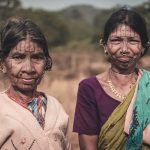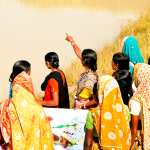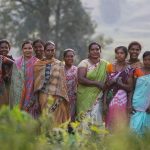Food Sovereignty and Local Economy
The story of inter-contentedness of the farm, livestock, forest, market and the household is the story of food sovereignty. A change in the equation of each of these aspects with each other can create a different agriculture that would affect the lifestyle, culture, ecology and health. Lets us look at what this means through the story of Harishchandra Sarkar of Munda village, Jigdi Panchayat and the work of our community mobilizer Nimal. Harishchandra owns 2 acres of paddy land, 3 acres of upland and around 1 acre of hill land. He had leased his paddy land to earn income from the land leased and farmed only in the upland and hill land.
Under the Alternative Methods for Agriculture and Food Sovereignty project, Grain Banks were started in some of the villages. In the grain bank, villagers contributed finger millet, rice and fox tail millet which was managed by 10 women in the village who were responsible for the smooth functioning of the grain bank. The villagers were categorized based on the months of food stress months they face based on the amount of land they had and if their produce sustained throughout the year. The first category of villagers came under more than 3 months of food stress, 2nd category of villagers facing 2 or more than 2 months of food stress and the last category were villagers facing 1 to 2 months of food stress. Villagers took grains from the bank and returned them during the next harvest.
Harishchandra in 2010 and 2011 used the grain bank grains during the food stress months and started growing more of Turmeric in the upland. By 2012, through the help of grain bank grains to get through the stress food months and selling his turmeric produce he was able to save enough money to get bank his paddy land that was given on lease. In 2012, Harishchandra decided to join the group of farmers working with Living Farms to change their farming pattern. With this Harishchandra also started following the Integrated Farming System. See the below image to understand how the local economy is bound to the agriculture. In the image below the Household/Family is in the centre of the economy where to the left upward is its’s farming land (Both upland for paddy and midland for millets) which gives food grains to eat and fodder given to the animals. Animals give milk,eggs and meat to eat and dung for manure. This cow dung is then used in preparing compost/manure along with leaves from the forest which goes back to the soil in the farm land and also to the Nutrition Gardens where vegetables are grown. The dung is also used for house maintenance and plastering the mud walls of the house regularly and for keeping the insects away.
The food grains from the farm and the nutrition garden is consumed and the surplus is sold for money which is then used for buying other products required, health care and to buy seeds. These seeds are used to grow food grains in the farm and garden which require strong fencing that is made using the wood and sticks acquired from the forests. The forests also provide with tubers, fruits and many uncultivated foods which are consumed and also sold in the market sometimes.




